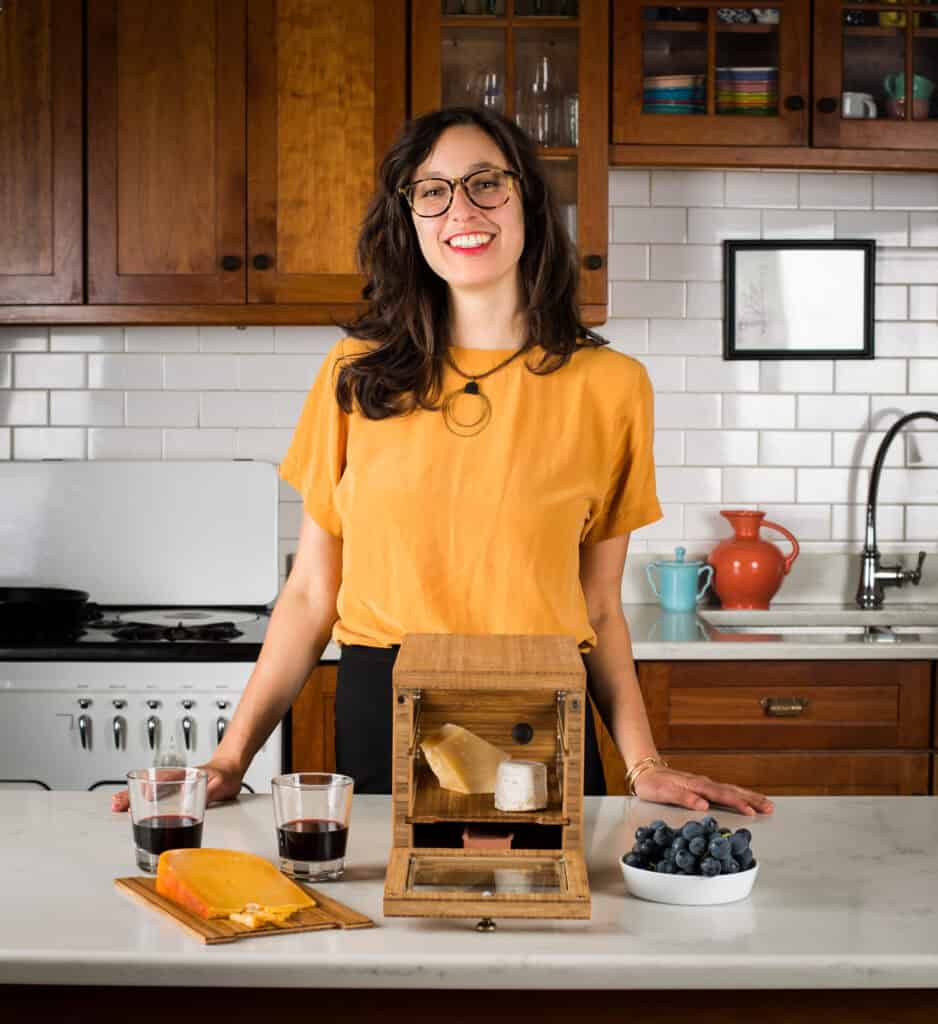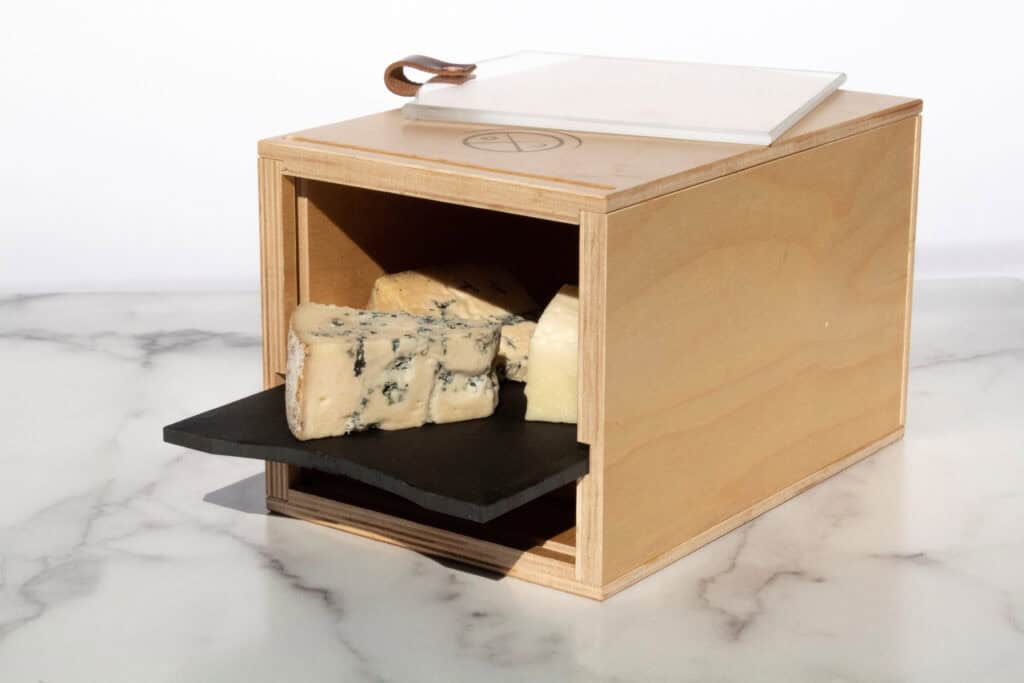Discover how Jessica Sennett revolutionized cheese storage

Jessica Sennett is the visionary behind the award-winning Cheese Grotto, the innovative cheese storage solution that brings the cheese cave to your countertop. With a background in food studies, Sennett’s cheese journey began with a thirst for knowledge and a palate primed for adventure. From exploring cheese caves in Europe to visiting farms across the US, she’s immersed herself in the world of artisanal cheese and has tried her hand at everything from mongering and making to writing and education.
Cheese Grotto started with one storage model and has grown into an online marketplace dedicated to American-made cheeses, offering monthly cheese subscriptions and virtual tastings so cheese lovers can come together and learn from makers.
culture caught up with Sennett to learn more about the strategy behind launching the Cheese Grotto, get her take on capitalism in the cheese industry (yes, we went there), and find out what’s next for the tenacious entrepreneur.
culture (CM): You have done a little bit of everything from writing and educating to mongering and making and now, owning your own business. It really seems like you have touched every part of this industry. So, I’m curious, how did cheese lure you in?
JS: I think the thing about cheese is that it’s a great meeting point when it comes to different interests. It’s satiating and grounding because it’s an everyday food item—even if it is a specialty one. But it also combines artistry and science to really develop and become what it is.
I dropped out of college after a year at UCLA because I really didn’t know what I was doing. I got hooked
up with a job at Cowgirl Creamery in the Ferry Building, which was a great way to meet people in the sustainable food industry. It felt like a really nice sense of community and a great portal to people and cultures around the world. Just trying the wheels over and over again really transformed my palate and my perception of what these cheeses can be, even from batch to batch from one maker.
That’s when I decided to go to France for cheese making apprenticeships, whch was a transformative time for me because I was able to really see the relationship between the land, the animals, and the final product.
CM: After your apprenticeships, did you ever think you would want to become a cheesemaker? You decided to pursue education, but was that a tough decision for you to make? Or was that pretty obvious?
JS: That is a good question. I mean, cheesemaking is an incredibly hard endeavor— you’re committing to a complete lifestyle [change] to become a cheesemaker. For me, growing up in San Francisco, it just felt like a very shocking turn for my life—to be in a more rural environment. Maybe not so much now, but when I was younger, I felt like maybe I wasn’t mentally strong enough for a cheesemaking lifestyle.
It’s a very demanding life. I have lots of respect for anyone who is pioneering this in the United States. But it does intimidate me to start and launch a cheesemaking line. We have been working closely with cheese subscriptions and gift boxes, and we’ve done a few collaborative cheeses with cheesemakers that are limited runs through our brand. So, that’s been rewarding to at least have a little bit of my hand in the process of creating something new.
CM: Now that you’re selling cheese online, there’s a whole new host of challenges and opportunities. Could you tell me about your decision to expand Cheese Grotto to include cheese sales and subscription boxes?
JS: From the business perspective, we have the one-time purchase of the Cheese Grotto, which is great, but it’s not a recurring revenue stream. You might come back and buy another for a friend, but how many do you really need?
It just made sense that if you have a Cheese Grotto, the other thing that you are going to need is cheese to put in the Grotto. And because there is also a lot of education around specialty cheeses—how to store them, different styles of cheeses—it gives us an opportunity to teach our customers about the best way to store different styles. So, that’s how the quarterly subscription came about.
CM: All of the cheeses you carry are American made. Why is it important for you to highlight American cheesemakers?
JS: We produce the Grottos in the United States, so I wanted to concentrate on American-made cheeses to focus on regionality. It works well with our bigger ethos around American-made and smaller-to-medium scale productions where you can actually monitor quality and have that touchpoint with customers, too.
CM: I will say, in doing my research for this, I did see lots of amazing customer service reviews. Everyone has great things to say about your customer service.
JS: It’s easy to forget that there are people on the other side when you purchase something from an online company. And at the end of the day, we’re still selling a very personal, perishable product to people, so we need to have that level of communication to make sure they’re happy.
If you have an online business and you don’t do that, you’re really missing out because it takes a while to get loyal customers online. You can get lost in the noise of how much is happening on the internet. So, if you have customers, you better revere them.
Speed Round
Cow’s milk, sheep’s milk, or goat’s milk? Sheep’s milk
Raw or pasteurized? Raw
Washed rind or bloomy rind? Washed rind
Favorite cheese (today)? Alemar Cheese Company St. James
Favorite cheese destination you’ve been to? Vermont
Cheese destination you want to go to? Comté region of France, Jura
CM: I assume your job takes you around the country and the world to explore different cheese production models. I’m wondering, what was the last trip you were on where you had that “pinch me” moment where you’re looking around thinking, is this real life?
JS: It’s been a while since I did much traveling, but one experience that sticks with me is touring the Luigi Guffanti underground caves while I was at the Slow Food Cheese festival in Bra, Italy. There’s an underground water source that runs through the cave and a pile of bricks along a wall that are either removed or stacked depending on how they want to control the humidity of the entire space. That was a light bulb moment, when you see something so simple yet so effective, that’s working with nature rather than against it to create something.
CM: I read something you wrote for the Inquisitive Eater about the evolution of the American artisan cheese industry. You questioned whether artisan cheese would be able to stay true to its grassroots origin in the face of economic pressure to expand and achieve profitability. It’s been 10 years since you wrote that; do you feel like what you wrote then represents how you feel today?
JS: Wow. I can’t believe you found that online. [I wrote that while attending the New School in New York City.]
Yeah, it’s always something that I contend with. I don’t think my values have changed much because I still like keeping things small and about the people and the care and artistry that goes into making these different styles [of cheese].
We’re always at odds with this capitalist framework. We have to operate within it, and it can be hard to stay true to the ideals that might have inspired you to get into the industry to begin with when you have to make financial decisions for your business. It’s very challenging to be up against the larger industrial agricultural system while trying to create and diversify food systems. The way to stay true to those values is to stay true to the people and the community producing [the cheese].

CM: I did notice that the new products you’ve developed since the original Grotto are all at lower price points than the original model. Is that so you can offer price accessibility?
JS: Definitely. But it also comes down to who the different models serve. For me, it really made sense when I was launching my business to start with the ultimate model. The most cheese nerd thing you could possibly make that would be better suited for people who have a very large refrigerator or kitchen.
That allowed us to actually get the business off the ground. From there, it was about trying to simplify the manufacturing and design elements to reach a larger audience.
We made the Piatto, the smallest one, because, I mean, I live in New York City, how much space do people really have for a Cheese Grotto in their kitchen?
Some people say it’s too expensive. But honestly, with the way inflation’s going, everything’s pretty reasonable.
CM: Absolutely. It’s a steal these days!
JS: We have not raised the prices at all. If you look at the Classico, there’s just so much woodworking detail. I’ve tried to bring that to a bigger manufacturing company and they said, “Yeah, this is made with a lot of love, but we’d have to really readjust the design for us to be able to make this.”
If you have an online business and you don’t do that, you’re really missing out because it takes a while to get loyal customers online. You can get lost in the noise of how much is happening on the internet. So, if you have customers, you better revere them.
I think people have lost a sense of appreciation for woodworking as well. They’re more willing to spend money on tech things than on these incredibly specialized skill sets.
CM: What are your aspirations for Cheese Grotto? Where do you see it going?
JS: Right now, we’re putting a lot of focus into our perishables and growing that subscription program online. And on the product side, it’s growing the amount that we’re able to produce. And then expanding internationally. We get a lot of international inquiries, but the shipping has always been a challenge. So, we’re working on making it a little more accessible.
CM: The idea of an American exporting a specialty cheese care product to Europe sounds fun to me.
JS: It’s definitely more of a slow burn with that one. First, it would be direct shipping to customers who want it. We’ve found over the years that being direct-to-consumer is really valuable for us because we’re a niche brand, and the Grotto itself is a niche product. We really want to be able to talk to the customers directly.



